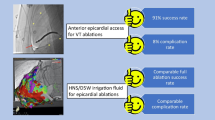Abstract
Pericardial access from a subxiphoid approach is often necessary to gain access to a critical epicardial substrate that is inaccessible from the endocardium. Although relatively safe, a rate of up to 5% of acute and 2% delayed complications has been reported. Intentional perforation of a distal coronary vein branch with pericardial insufflation of CO2 to create a negative contrast space anterior to the right ventricle is an emerging approach to facilitate pericardial access. In this report, we describe the technique of intentional coronary vein exit with CO2 insufflation to perform epicardial mapping and ablation of ventricular tachycardia (VT) in a step-by-step approach and review the published literature on this topic.






Similar content being viewed by others
References
Scanavacca MI, Venancio AC, Pisani CF, et al. Percutaneous transatrial access to the pericardial space for epicardial mapping and ablation. Circ: Arrhythmia Electrophysiol. 2011;4:331–6.
Sacher F, Roberts-Thomson K, Maury P, et al. Epicardial ventricular tachycardia ablation. J Am Coll Cardiol. 2010;55:2366–72.
Gunda S, Reddy M, Pillarisetti J, et al. Differences in complication rates between large bore needle and a long micropuncture needle during epicardial access: time to change clinical practice? Circ Arrhythm Electrophysiol. 2015;8:890–5.
Juliá J, Bokhari F, Uuetoa H, et al. A new era in epicardial access for the ablation of ventricular arrhythmias: the Epi-Co2 registry. JACC: Clin Electrophysiol. 2021;7:85–96.
Greenbaum AB, Rogers T, Paone G, et al. Intentional right atrial exit and carbon dioxide insufflation to facilitate subxiphoid needle entry into the empty pericardial space: first human experience. JACC Clin Electrophysiol. 2015;1:434–41.
Silberbauer J, Gomes J, O’Nunain S, Kirubakaran S, Hildick-Smith D, McCready J. Coronary vein exit and carbon dioxide insufflation to facilitate subxiphoid epicardial access for ventricular mapping and ablation: first experience. JACC Clin Electrophysiol. 2017;3:514–21.
Cronin EM, Zweibel SL. Transatrial pericardial insufflation of carbon dioxide to facilitate percutaneous pericardial access for ablation of ventricular tachycardia. J Cardiovasc Electrophysiol. 2016;27:615.
AlQubbany A, Almehmadi F, Zagzoog A, Osta W, Ahmad A, Silberbauer J. Phrenic nerve preservation using carbon dioxide insufflation during sinus node ablation procedure. HeartRhythm Case Rep. 2021;7:347–50.
Sosa E, Scanavacca M, D’Avila A, et al. Endocardial and epicardial ablation guided by nonsurgical transthoracic epicardial mapping to treat recurrent ventricular tachycardia. J Cardiovasc Electrophysiol. 1998;9:229–39.
Sacher F, Roberts-Thomson K, Maury P, et al. Epicardial ventricular tachycardia ablation a multicenter safety study. J Am Coll Cardiol. 2010;55:2366–72.
Leyton-Mange JS, Sze EY, Conley C, Vasaiwala SC, Sesselberg HW. Epicardial access facilitated by carbon dioxide insufflation for redo ventricular tachycardia ablation in a patient with arrhythmogenic right ventricular dysplasia and dense adhesions. HeartRhythm Case Rep. 2021;7:197–202.
AlQubbany A, Almehmadi F, Zagzoog A, Osta W, Ahmad A, Silberbauer J. Phrenic nerve preservation using carbon dioxide insufflation during sinus node ablation procedure. HeartRhythm Case Reports. 2021;7:347–50.
Funding
This study was partially supported by the Winkelman Family Fund in Cardiovascular Innovation and the Pennsylvania Steel Company EP Research Fund. The funder played no role in the conduct of the study, preparation of the manuscript, or the decision to submit the publication.
Author information
Authors and Affiliations
Corresponding author
Ethics declarations
Ethics approval
All patients provided written informed consent for both the ablation procedure and inclusion in a registry approved by the University of Pennsylvania Health System’s Institutional Review Board.
Conflict of interest
The authors declare no competing interests.
Additional information
Publisher's note
Springer Nature remains neutral with regard to jurisdictional claims in published maps and institutional affiliations.
Supplementary Information
Below is the link to the electronic supplementary material.
Supplementary file1 (MP4 1342 KB)
Supplementary file2 (MP4 1164 KB)
Supplementary file3 (MOV 1548 KB)
Supplementary file4 (MP4 2564 KB)
Supplementary file5 (MP4 1217 KB)
Supplementary file6 (MP4 7657 KB)
Rights and permissions
Springer Nature or its licensor holds exclusive rights to this article under a publishing agreement with the author(s) or other rightsholder(s); author self-archiving of the accepted manuscript version of this article is solely governed by the terms of such publishing agreement and applicable law.
About this article
Cite this article
Cerantola, M., Santangeli, P. Epicardial access facilitated by carbon dioxide insufflation via intentional coronary vein exit: step-by-step description of the technique and review of the literature. J Interv Card Electrophysiol 66, 109–116 (2023). https://doi.org/10.1007/s10840-022-01338-2
Received:
Accepted:
Published:
Issue Date:
DOI: https://doi.org/10.1007/s10840-022-01338-2




